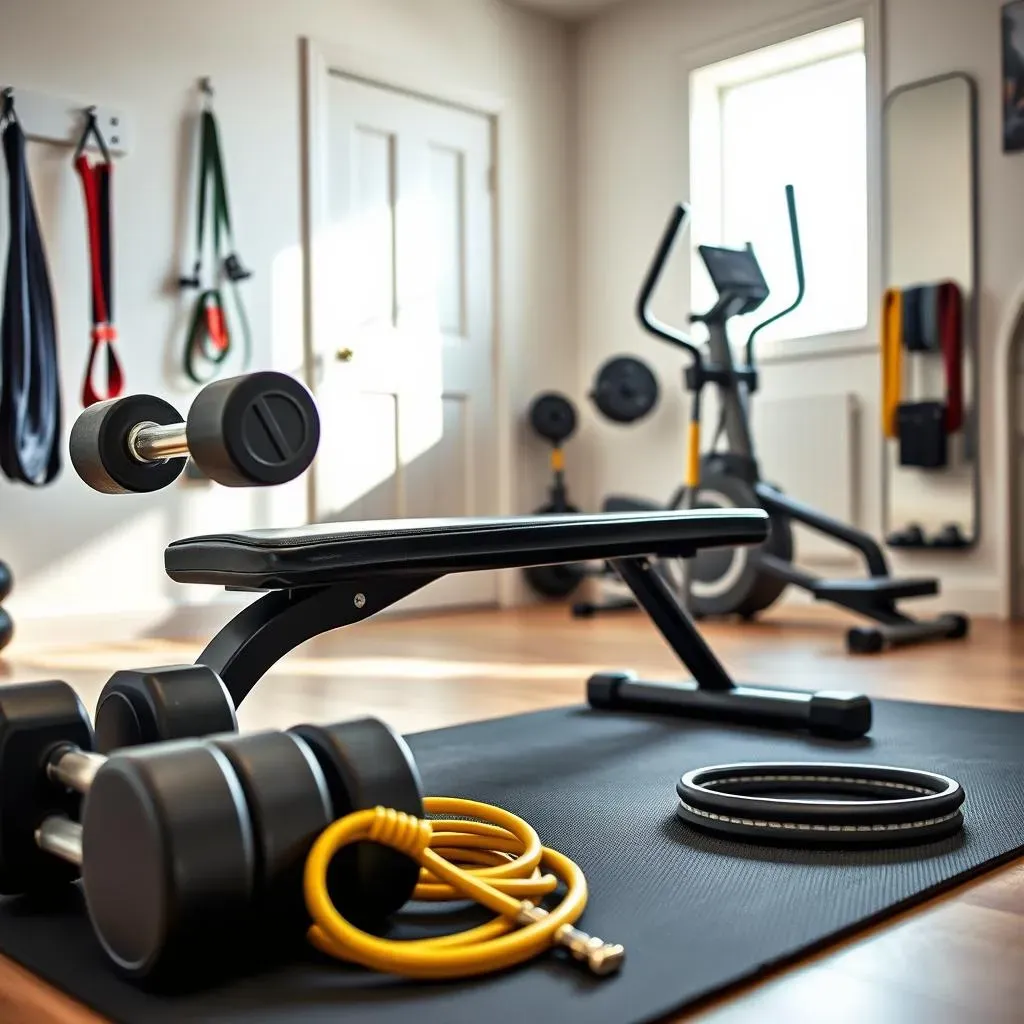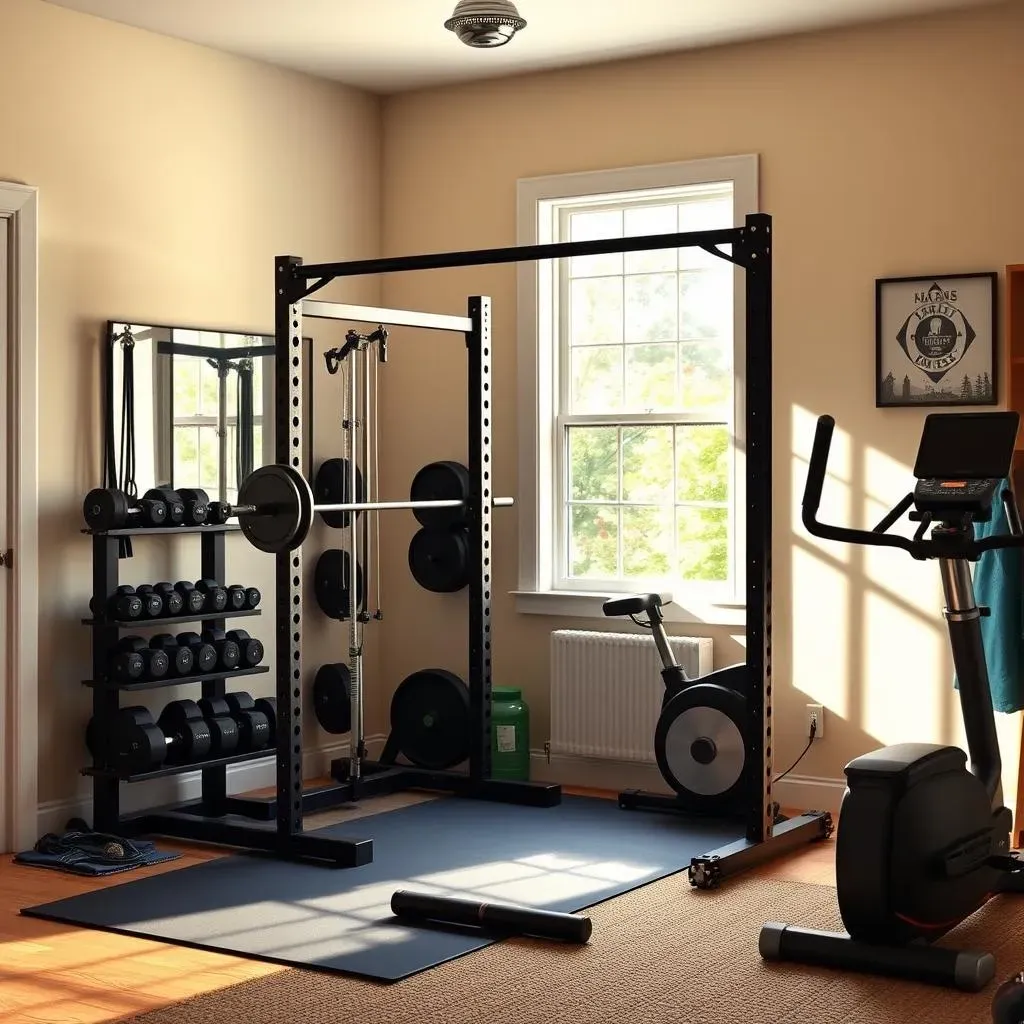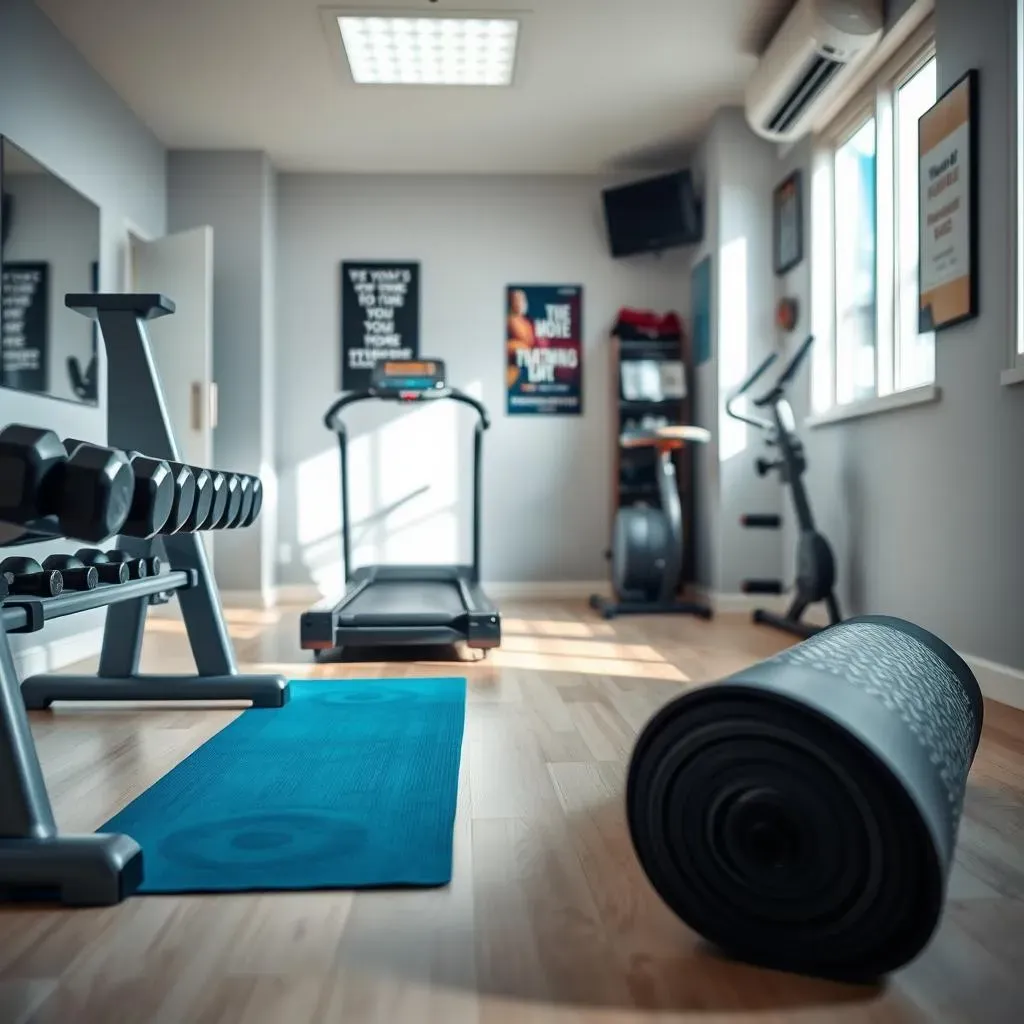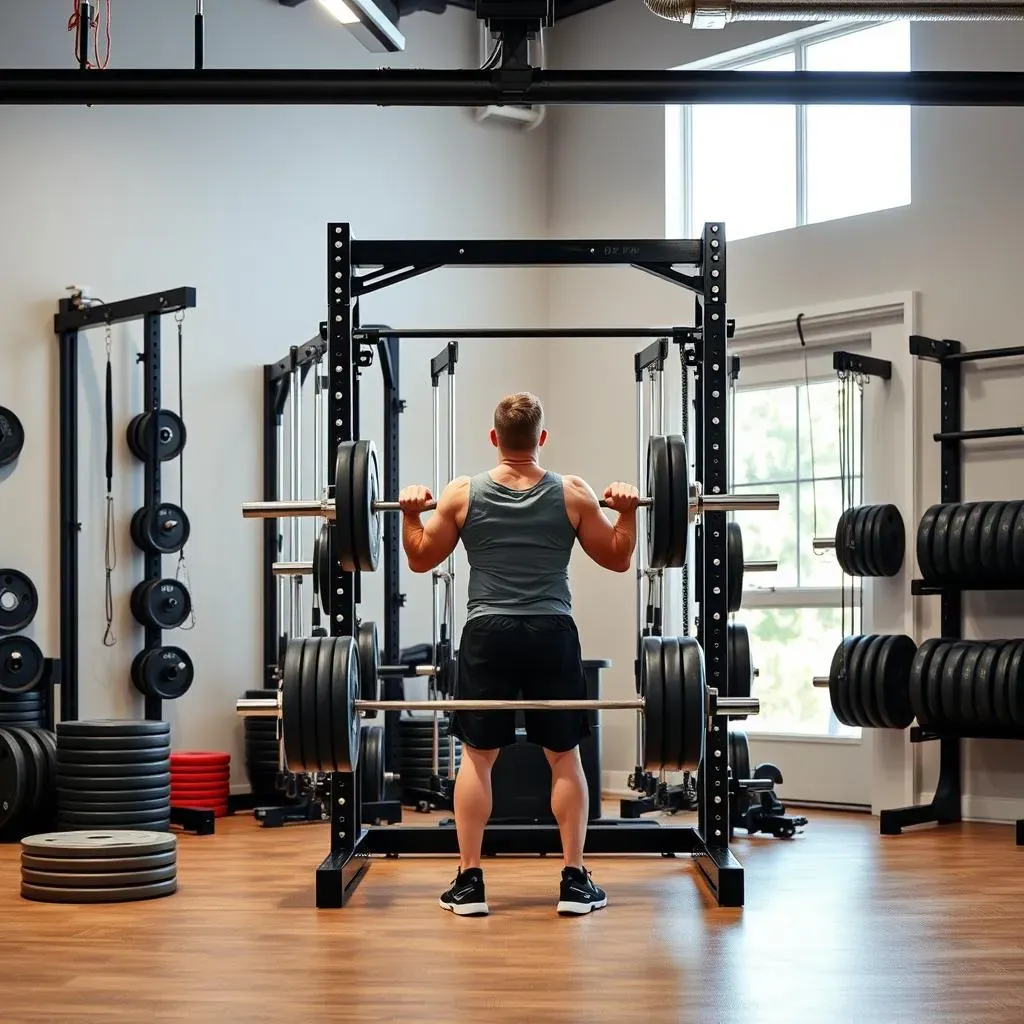Table of Contents
Ready to ditch the crowded gym and sculpt your dream physique from the comfort of your own home? Investing in quality home gym equipment is the first step towards achieving your fitness goals on your own terms. But with countless options flooding the market, knowing where to start can feel overwhelming. Don't sweat it! This guide is your roadmap to building the perfect home gym, tailored to your fitness level, space, and budget. We'll explore essential equipment for beginners, discuss how to optimize your workout space, and delve into advanced options for seasoned athletes. From selecting the right weights to mastering maintenance, we'll equip you with the knowledge to create a workout haven that motivates and empowers you. Get ready to transform your living space into a personal fitness sanctuary and unlock your full potential with the right quality home gym equipment!
Essential Quality Home Gym Equipment for Every Fitness Level
Essential Quality Home Gym Equipment for Every Fitness Level
The Foundational Five: Must-Have Equipment
Every great home gym starts with a solid foundation. These five pieces of quality home gym equipment are versatile enough to support a wide range of exercises, making them ideal for beginners and experienced fitness enthusiasts alike.
First, adjustable dumbbells are your best friend for strength training. They save space and allow you to gradually increase the weight as you get stronger. Next, a sturdy weight bench is crucial for chest presses, rows, and other essential exercises. Don't skimp on quality here; a wobbly bench can lead to injuries. A good set of resistance bands offers a surprising amount of versatility for assisted pull-ups, mobility work, and adding resistance to various exercises. A jump rope is a cheap and effective way to boost your cardio and improve coordination. Finally, a comfortable and supportive exercise mat protects your joints and provides a stable surface for floor exercises.
Cardio Essentials: Getting Your Heart Pumping
While strength training is important, cardio is essential for overall health and fitness. Luckily, you don't need a massive treadmill to get your heart rate up at home. A compact elliptical machine is a great low-impact option that's easy on the joints. If you're short on space, consider an air bike, which provides a challenging full-body workout in a small footprint. For those who prefer outdoor workouts, a heart rate monitor watch can track your progress and keep you in the optimal training zone. And don't forget the power of bodyweight exercises like burpees, mountain climbers, and jumping jacks – no equipment required!
Recovery and Mobility: Don't Neglect These Essentials
Overtraining is a common pitfall for home gym enthusiasts. Make sure you prioritize recovery and mobility to prevent injuries and maximize your results. A foam roller is an inexpensive tool for self-massage, helping to release muscle tension and improve flexibility. A set of lacrosse balls can target specific trigger points for deeper tissue work. A pull-up bar mounted in a doorway is perfect for stretching your shoulders and back, while also providing an opportunity for pull-up training. And finally, don't underestimate the power of a simple stretching routine. Incorporate static and dynamic stretches into your workouts to improve your range of motion and reduce your risk of injury.
Sample Recovery Tools Comparison
Tool | Benefits | Price Range |
|---|---|---|
Foam Roller | Muscle recovery, flexibility | $15 - $50 |
Lacrosse Ball | Targeted trigger point release | $5 - $15 |
Pull-up Bar | Stretching, pull-up training | $20 - $60 |
Setting Up Your Quality Home Gym: Space, Budget, and Equipment Choices
Setting Up Your Quality Home Gym: Space, Budget, and Equipment Choices
Assessing Your Space and Defining Your Fitness Goals
Before you start buying equipment, take a good look at your available space. Is it a spare room, a corner of your garage, or just a small area in your apartment? Measure the dimensions and consider the ceiling height, especially if you plan on doing overhead exercises. Next, define your fitness goals. Are you looking to build muscle, lose weight, improve your cardio, or a combination of these? Your goals will dictate the type of quality home gym equipment you need. A powerlifter will have very different needs than someone who's primarily interested in yoga and Pilates. Think about what kind of workouts you enjoy and what you're most likely to stick with. There's no point in buying a fancy treadmill if you hate running!
Once you have a clear understanding of your space and goals, you can start to prioritize your equipment choices. Consider multi-functional equipment that can serve multiple purposes. For example, a power rack with a pull-up bar can be used for squats, bench presses, pull-ups, and more. Adjustable dumbbells are another great space-saving option. If you're on a tight budget, focus on the essentials first and gradually add more equipment as your needs and budget allow.
Budgeting Wisely and Finding the Best Deals on Quality Home Gym Equipment
Setting a budget is crucial to avoid overspending and ensure you get the most bang for your buck. Research the prices of different equipment options and compare prices from various retailers. Don't be afraid to buy used equipment, especially if you're on a tight budget. You can often find high-quality home gym equipment at a fraction of the price of new equipment. Check online marketplaces, classified ads, and local fitness equipment dealers. However, be sure to inspect used equipment carefully before you buy it to ensure it's in good working condition.
Also, consider financing options if you're planning on making a large purchase. Many retailers offer financing plans with low or zero interest rates. However, be sure to read the fine print and understand the terms and conditions before you sign up. Finally, don't be afraid to negotiate prices, especially if you're buying multiple items or paying in cash. You might be surprised at how much you can save by simply asking for a better deal. Remember, building a quality home gym is an investment in your health and well-being, but it doesn't have to break the bank.
Maintaining and Maximizing Your Quality Home Gym Equipment
Maintaining and Maximizing Your Quality Home Gym Equipment
Cleaning and Care: Extending the Life of Your Investment
You've invested in quality home gym equipment, now it's time to protect that investment. Regular cleaning and maintenance are crucial for extending the life of your equipment and ensuring it remains safe and functional. Wipe down your equipment after each use with a clean, damp cloth to remove sweat and grime. For tougher stains, use a mild soap and water solution. Avoid using harsh chemicals or abrasive cleaners, as these can damage the surfaces of your equipment. Pay special attention to moving parts, such as hinges and cables, and lubricate them regularly with a silicone-based lubricant. Check for loose bolts and screws and tighten them as needed. And don't forget to vacuum or sweep your workout area regularly to remove dust and debris.
Proper storage is also essential for maintaining and maximizing your quality home gym equipment. Store your equipment in a dry, well-ventilated area to prevent rust and corrosion. If you live in a humid climate, consider using a dehumidifier to reduce moisture levels. Cover your equipment with a protective tarp or cover when not in use to shield it from dust and sunlight. And be sure to store weights and other heavy objects properly to prevent accidents. A little bit of care and attention can go a long way in keeping your quality home gym equipment in top condition for years to come.
Optimizing Your Workout Space: Layout, Lighting, and Motivation
Creating an inviting and functional workout space is just as important as having the right equipment. Think about the layout of your gym and how you can maximize the available space. Position your equipment so that you have enough room to move freely and safely. Avoid cluttering your workout area with unnecessary items. Good lighting is essential for creating a motivating and energizing atmosphere. Natural light is ideal, but if that's not possible, use bright, full-spectrum light bulbs. Consider adding mirrors to your gym to help you monitor your form and track your progress. And don't forget the importance of music. Create a workout playlist that gets you pumped up and motivated.
Personalize your workout space with motivational posters, artwork, or other items that inspire you. Consider adding a TV or streaming device so you can watch workout videos or listen to podcasts while you exercise. And don't forget the importance of ventilation. Make sure your gym is well-ventilated to prevent overheating and improve air quality. A simple fan can make a big difference. By optimizing your workout space, you can create a home gym that you actually enjoy using, making it more likely that you'll stick with your fitness routine. Remember, consistency is key to achieving your fitness goals, and a well-designed home gym can help you stay motivated and on track. Think about what kind of environment inspires you and create a space that reflects your personal style and preferences. A quality home gym is more than just a collection of equipment; it's a sanctuary for your health and well-being.
Element | Importance | Tips |
|---|---|---|
Layout | Maximizes space, safety | Ensure free movement, avoid clutter |
Lighting | Motivation, energy | Use bright, full-spectrum bulbs |
Mirrors | Form monitoring, progress tracking | Position strategically to view your entire body |
Music | Motivation, enjoyment | Create an energizing playlist |
Ventilation | Air quality, prevents overheating | Use a fan or open a window |
Advanced Quality Home Gym Equipment: Taking Your Workouts to the Next Level
Advanced Quality Home Gym Equipment: Taking Your Workouts to the Next Level
Power Racks and Functional Trainers: The Cornerstones of Advanced Strength Training
Ready to take your strength training to the next level? A power rack is a must-have for serious lifters. It provides a safe and versatile platform for squats, bench presses, overhead presses, and more. Look for a rack with adjustable safety pins or straps to protect you from injury if you fail a lift. A functional trainer, also known as a cable machine, offers a wide range of exercise possibilities, allowing you to target different muscle groups with varying angles and resistance. These machines are great for developing functional strength and improving your overall athleticism. When selecting a power rack or functional trainer, prioritize quality and stability. Look for a sturdy frame, smooth cables, and durable hardware. And be sure to choose a model that fits your space and budget.
Investing in a quality power rack or functional trainer opens up a whole new world of training possibilities. You can perform advanced exercises like rack pulls, pin squats, and cable flyes, which are difficult or impossible to do with dumbbells or barbells alone. These exercises can help you break through plateaus, build more muscle, and improve your overall strength and power. However, it's important to learn proper form and technique before attempting these advanced exercises. Consider working with a qualified personal trainer to ensure you're performing the exercises correctly and safely.
Specialty Barbells and Weight Plates: Fine-Tuning Your Training
Once you've mastered the basics, consider adding specialty barbells and weight plates to your home gym. A barbell with a thicker diameter can improve your grip strength and challenge your muscles in new ways. Bumper plates, made of solid rubber, are designed to be dropped from overhead without damaging your floor or equipment. These are essential for Olympic weightlifting exercises like snatches and clean and jerks. Calibrated weight plates, which are precisely weighted to within a few grams, are a must-have for competitive powerlifters and anyone who wants to track their progress accurately.
Choosing the right specialty barbells and weight plates depends on your individual goals and preferences. If you're primarily interested in powerlifting, a stiff barbell with aggressive knurling is a good choice. If you're more focused on Olympic weightlifting, a flexible barbell with smooth rotation is essential. And if you're simply looking to add variety to your training, consider a cambered barbell or a safety squat bar. No matter what you choose, be sure to prioritize quality and durability. Look for barbells and weight plates made from high-quality materials with solid construction. Remember, your quality home gym equipment is an investment in your health and fitness, so choose wisely and take care of it properly.
Equipment | Benefits | Considerations |
|---|---|---|
Power Rack | Versatile, safe for heavy lifting | Space requirements, cost |
Functional Trainer | Wide range of exercises, functional strength | Cost, complexity |
Specialty Barbells | Improved grip, targeted muscle activation | Specific training goals, cost |
Bumper Plates | Safe for dropping, Olympic lifting | Cost, noise |
Conclusion: Your Personalized Path to Fitness with Quality Home Gym Equipment
Building a home gym is an investment in yourself, your health, and your future. By carefully selecting quality home gym equipment that aligns with your fitness goals, space, and budget, you can create a personalized workout environment that inspires you to achieve lasting results. Remember to prioritize safety, maintenance, and continuous learning to maximize the benefits of your home gym. Whether you're just starting your fitness journey or are a seasoned athlete, the right equipment can empower you to reach new heights, all from the convenience and comfort of your own home. So, take the leap, invest wisely, and get ready to transform your life, one rep at a time, with your very own quality home gym equipment.